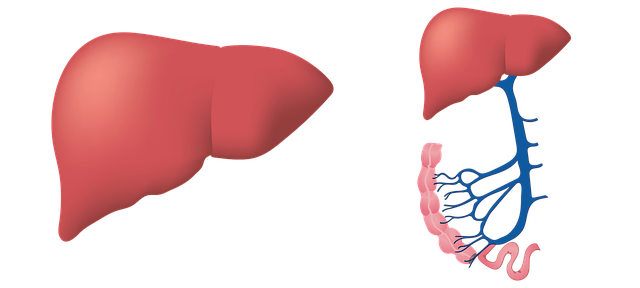Detoxification in detail - Part 2: The liver (The two phases of detoxification)
Hello.
It's a pleasure to meet you again for this second part of the series on detoxification.
In the first part, which I invite you to read (if you haven't already done so), we saw that detoxification does exist. I believe that almost everyone agrees on this, but on the other hand, that it is wrong to say that we cannot influence this detoxification.
Of course we can influence it, positively or negatively, and this depends on the energy available for this action in the organism. Because we have seen that digestion takes a lot of energy, that cogitation takes a lot of energy, physical action too, and that if we spend our time digesting, thinking and getting agitated, there is very little energy available for the famous detoxification.
So yes, we can influence, and yes there are diets that are conducive to detoxification, simply because they lighten the digestive load. Less digestive energy is needed, because these foods are much more digestible, because they are in smaller quantities.
It is also false to say that the detoxification organs, especially the liver, work perfectly in everyone. This is completely wrong.
Most of the livers of our contemporaries (including myself) are more or less damaged. At one time, a friend of mine had Hepatitis C and it took a while for him to get his liver back to working properly. Liver dysfunction will cause many symptoms. And the fact that many people share these symptoms is a clear indication that no, our detoxification organs are not perfect.
There are detoxification diets and approaches to detoxification that aim firstly to free up energy for these detoxification phases, the extreme expression of this being what is called fasting, and secondly, that aim to restore the functioning of those organs that are necessary for detoxification.
That was the package we saw in the first article of this series. In this one, we will really focus on the liver.
So if I give you this corpus of notions, it is not for intellectual pleasure, but it is simply because it is absolutely necessary.
Our liver, the largest organ in the body, is located on the right and extends a little to the left. The liver is the organ of detoxification par excellence. Among its many other tasks, it neutralizes all the toxins present in our body. There are substances that come from within, the endotoxins that are produced by our body as a result of normal metabolism. Every functioning organism produces waste, and this waste is toxic for the organism, it must be evacuated.
A living organism consumes and produces waste and it must be evacuated. Because by definition, a waste is a product that cannot be used by the system, it must be evacuated. There are all these endotoxins, and then there are the exotoxins, the toxins coming from the external environment.
In our time and since the last 60 years, it is the party of the exotoxin: pesticides, fungicides, food additives, dyes... They are all toxic products; heavy metals in the environment, aluminum in vaccines...
Really. There is a huge dose of endotoxins and especially exotoxins. This is where we see the difference, i.e. before, everyone had their little endotoxins and the body could deal with them.
There is a detoxification organ. So it is expected that the body needs to detoxify itself. This is not something abnormal. It's normal but in a certain proportion. All the endotoxins, the body was relatively well equipped to handle them.
The problem is the arrival of the exotoxins that have put a bit of chaos in all this. The liver will filter the blood, especially because the blood comes from the intestines. When nutrients pass through the intestines, they are brought back via a vein called the portal vein.
They are brought directly to the liver which will detoxify the blood. The intestines are our first rampart, our first barrier. The liver is the second barrier of the body that will neutralize the toxic products.
And a perfectly functioning liver will detoxify 99% of the toxic products that could have been in the food bowl. A liver that is damaged will only filter a small part of them. And all these chemicals that are going to pass into the bloodstream, automatically what are they going to do?
All these toxic products that are going to pass into the bloodstream are going to create disorder. To give you a little idea, what do we typically see? Multiple food and chemical sensitivities, people who are poly allergic...
So multiple sensitivities to medications, chemicals, foods in general, alcohol and coffee.
People who, as soon as they have a cup of coffee, are in full throttle, it means that their liver is not functioning in a totally adequate way. It means that their liver is not detoxifying the alcohol very well.
How does the liver work?
We are going to do it very quickly, we are not going to make it extremely complex, but it is interesting to know how to act naturally and without any danger.
So it happens in two phases:
There is phase 1 of detoxification which is called the addition phase. In fact, most of the toxins in the body are fat-soluble, meaning that they are soluble in fat. They are accompanied by fat, so the most toxic products are stored in the fat of the individual. And when we start fasting and burning our fat, we automatically release these products.
The fact that they are trapped in the fats protects the body against the aggressiveness of these wastes, but on the other hand, it has a disadvantage. It is very difficult to eliminate them by water, with the urine.
It is very difficult. In phase 1, the liposoluble chemicals, that is to say that they have no electric charge, they are not polar, in this phase called addition, they will receive an electric charge to become water-soluble. There is a first process of transformation. It happens with enzymes called cytochromes P450.
It is a family of several tens, even several hundreds of enzymes (hence the essential role of enzymes) which will start to break down these products, to transform them. This is interesting because it often transforms them into less toxic products. So the first phase will decrease the toxic potential of the products and sometimes it transforms them into more toxic products.
There must automatically be a phase 2 that does not lag behind, because otherwise we will end up with more toxic products. For example, the detoxification of alcohol leads to the production of acetaldehyde which is extremely toxic.
The decomposition of proteins leads to the production of ammonia which is then transformed into urea, ammonia being very toxic. If we stayed at the ammonia stage, it would be very toxic for the body. The majority of this phase occurs in the liver -- the addition phase -- a little bit in the lungs and in the kidneys, but mainly in the liver.
In this phase, many elements are needed to produce these enzymes, many micro nutrients such as zinc, manganese, magnesium, sulfur, selenium and copper, all of which, unfortunately, are lacking in today's diet because our fruits and vegetables no longer grow in rich soils, and the least we can do is to turn to an organic diet, rich in mineral matter
Processing and industrialization processes mean that food has lost much of its vital charge, hence the need to consume as much raw, organic fruit and food as possible to counteract this problem. So there is a need for a lot of micro nutrients to support this phase, especially sulfur, which can be found in cabbage, in garlic, in onions, in the whole cabbage family.
And you'll see that sulfur plays an essential role in detoxifying the body. So in phase 1, the cytochromes P460 will transform liposoluble products -- soluble in lipids -- into water-soluble products. There is an elimination of these toxic products which is done directly.
Fat-soluble products that cannot be adequately transformed are eliminated by the biliary route. The liver sends a product called bile, which is a fatty product, to the intestines and it is eliminated by the intestinal route. All the bile produced is used to eliminate a lot of detoxification waste.
The problem is that because it's rejected at the beginning of the small intestine, if your small intestine is ultra-porous, chances are you're reabsorbing what the liver just dumped into the small intestine and that's not good. Hyper-permeability will complicate things. So phase 1 can be inhibited by many things, especially benzodiazepines, antihistamines, all the anti-allergy stuff.
Unfortunately, in this day and age, when someone is allergic to several products. What do we do? We give them histamine blockers, which is the marker of allergy. And what does that do? It makes him even more allergic because he is less able to detoxify the toxic products that were already in his body.
Many of today's allopathic drugs block this detoxification phase of the liver. There is a kind of logic in which the normal cleansing reactions of the body are prevented. You inhibit the reaction and you make the body even more unable to defend itself. The solution must come from outside. The solution pays off, extremely paying off in terms of resignation and taking power over you from the outside and paying off in terms of money. This is the logic of the system: Sell, sell, sell, submit, submit, submit.
You, on the other hand, can accelerate this detoxification phase, firstly by devoting energy to it, by stopping digesting all day long, and thinking all day long. Then there is an active principle called limonene, which is found in oranges, lemons and mandarins.
This active ingredient greatly activates phase 1 of liver detoxification. All sulphurous elements: broccoli, cauliflower, red cabbage, white cabbage, green cabbage, kale. All the small cabbages, the group of radishes, the cruciferous family, the turnips, all that will accelerate phase 1, it will feed it, it will induce active principles which will help the body to make enzymes, cytochromes P450 which will be useful for detoxification.
The problem is always the same. This phase 1, if it starts to be overloaded because there is too much demand, too many polluting principles and too many toxic products in the organism, it becomes saturated.
Then there is phase 2 in which we will take the water-soluble products, we add chemical elements to the products to make them permanently water-soluble and allow their renal elimination in particular.
I'm not going to give you the whole list, but there's acetylation, for example. This is useful for removing protein residues. To remove ammonia, acetylation is what comes into play. Then there is the glucuronidation, it is the elimination of what we call xenobiotics. Xenobiotics, a nice word that is a little bit scary, are all the products that are present in a living organism and that are foreign to it: pesticides, fungicides and herbicides, all that is glucuronidation.
Then there is the conjugation with a product called glutathione. Glutathione is a major antioxidant. It is one of the main antioxidants that will fight against free radicals. There are quite a few free radicals that are formed during phase 1.
The conjugation with glutathione from sulfur (a lot of sulfur equals a lot of glutathione). We talk about it a lot when we talk about detoxification of heavy metals. It is a major conjugation agent of the organism. There is also what is called methylation. Methylation is used for the elimination of adrenaline, noradrenaline, testosterone and serotonin as well.
Yes, because we are constantly eliminating hormones. Moreover, we will see that people who suffer from a phase 1 or phase 2 deficiency, for example, will find themselves in hormonal overload. And women in particular will have too much estrogen in their bodies. Why? Because their liver no longer eliminates estrogen.
Then what is it?
There is the conjugation with sulfur which is quite similar to the conjugation with glutathione, which helps eliminate all the herbicides, fungicides and pesticides that come from our food that is supposed to bring us life, and ultimately brings us death.
So in summary
Phase 1 consists of blood filtration and bile excretion, beginning to transform chemicals and toxins and converting fat-soluble toxins into water-soluble products.
Phase 2 uses enzymes from the liver to allow for better degradation and elimination through the urinary or intestinal tract.







Excellent information!
Congratulations @mezzane! You have completed the following achievement on the Hive blockchain and have been rewarded with new badge(s):
Your next target is to reach 300 upvotes.
You can view your badges on your board and compare yourself to others in the Ranking
If you no longer want to receive notifications, reply to this comment with the word
STOPSupport the HiveBuzz project. Vote for our proposal!